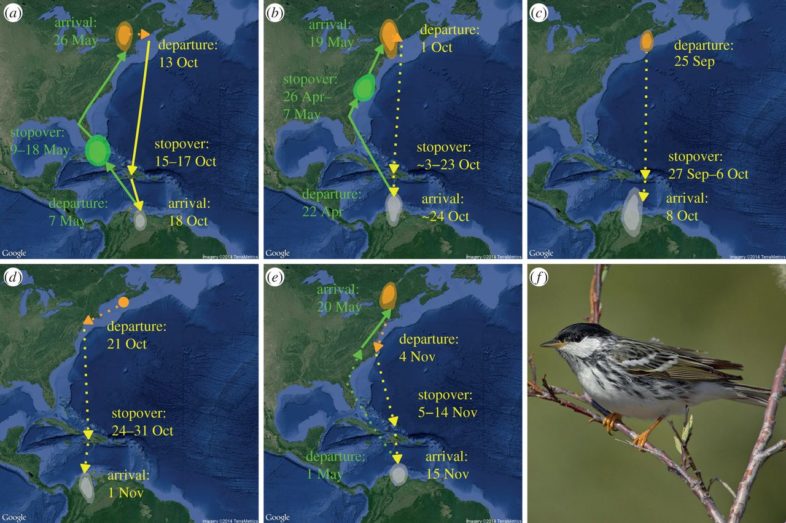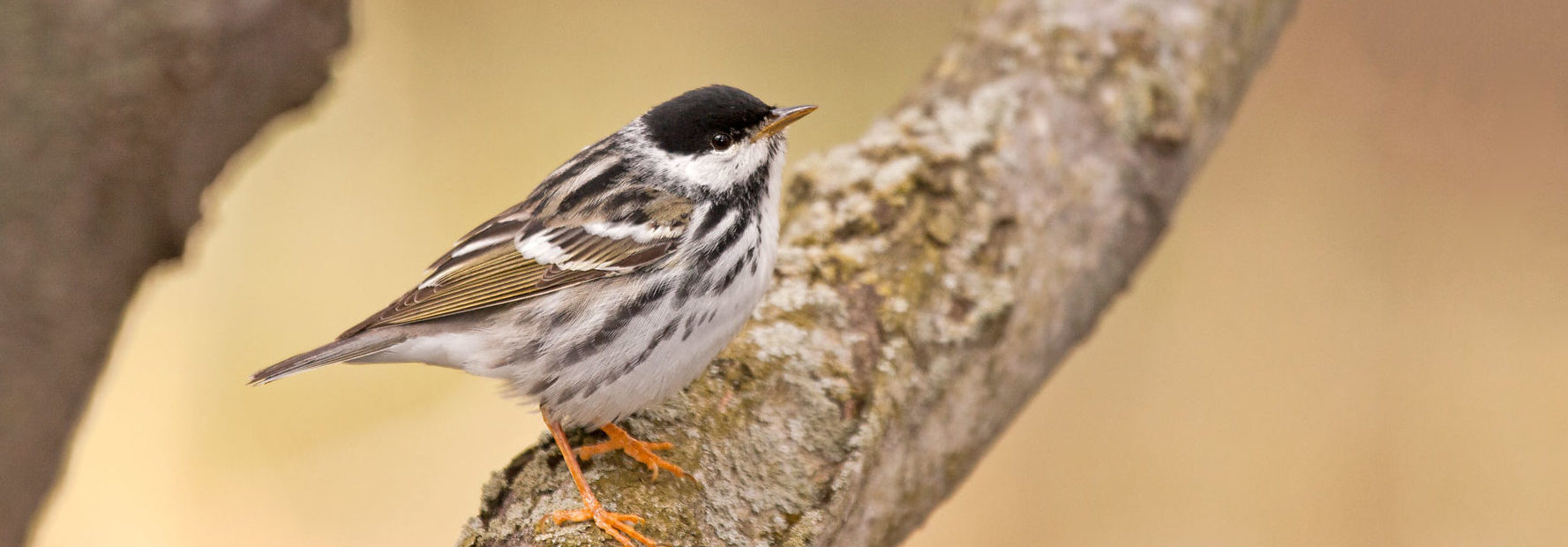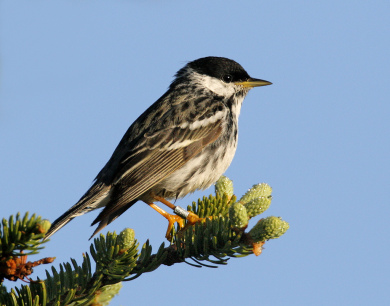Hold two nickels and a dime in your hand. That's the summer weight of a Blackpoll Warbler. This black-capped songbird nests from the mountain forests of New England across the boreal forest to Alaska. After an epic migration, Blackpoll Warblers spend their winters in northern South America.
On the breeding grounds
Blackpolls are insectivorous and one of the largest warblers (12-13 g). This relatively large body size is probably a benefit during freezing nights on its breeding grounds and on its long migratory flights. The male (marked-with his black cap [or “poll”]) sings his high-pitched song from treetops throughout his territory. During June, the song is a characteristic feature from the stunted spruce-fir forests that crown higher peaks of the Northeast to the lowland boreal evergreen forests.
Female Blackpoll Warblers build their bulky, well-concealed nests low in conifers without the help of their mate. Three to five creamy buff or greenish eggs are laid, and only the female Blackpoll Warblers incubate. The female’s cryptically-colored plumage pattern may help them avoid predation from Sharp-shinned Hawks (Accipiter striatus), which are known to depredate nestlings and possibly attending adults as well.
An epic migration to the wintering grounds
For more than a century, ornithologists have debated the route (inland vs. transoceanic) that Blackpoll Warblers take on their fall migration to northern South America. In October, Blackpoll Warblers amass on the north Atlantic Coast, where they double their weight gorging on insects and berries. And then a cold front arrives from the north…and they depart at sunset into the darkness.

Migration routes, stopover locations and winter distributions of five blackpoll warblers (a–e) breeding in northeastern North America, as inferred from light-level geolocators. Lines represent migratory (yellow: autumn migration; green: spring migration) and premigratory (orange) movements. Figure 1 from DeLuca et al. (2015). DOI: 10.1098/rsbl.2014.1045
Bill DeLuca (Northeast Climate Science Center) and VCE definitely solved this great modern-day avian mystery. Using light-level geolocators attached to Blackpoll Warblers in Vermont and Nova Scotia, DeLuca and colleagues documented the longest distance non-stop overwater flights ever recorded for a migratory songbird. During October, Blackpoll Warblers initiate a ~3-day non-stop transoceanic flight of ~2500 km from the north Atlantic Coast to Hispaniola and Puerto Rico. Radar data show migrating songbirds fly between 2,600 and 20,000 feet while making this journey. After a few weeks, they fly onto Columbia or Venezuela where they overwinter. Their spring migration route takes them over Cuba to Florida, where they journey up the eastern US seaboard to reach their breeding grounds in late May.
Conservation Concerns
The 2014 State of the Birds Report listed the Blackpoll Warbler as a ‘Common Bird in Steep Decline’. In the U.S., Blackpoll Warbler populations have likely declined by 7.8% per year (1966 to 2015), resulting in a cumulative decline of 98 percent.
Our trend data from Mountain Birdwatch (2011-2019) and the State of the Mountain Birds Report support these staggering declines. While migrating Blackpoll Warblers are sometimes killed in large numbers by wind and communication infrastructure, these mortalities are insufficient to explain the long-term steady declines of Blackpoll Warblers across their range. Currently, no consensus exists to explain these declines.
Our research actions
Alarmed by the steep decline of U.S. Blackpoll Warbler populations, VCE is currently developing several lines of research to elucidate some of the factors limiting Blackpoll Warbler populations in the northeastern U.S. Currently, Jason Hill is finishing up an investigation into upslope range expansion by Blackpoll Warblers in New England and these results will be published by the end of 2020.


